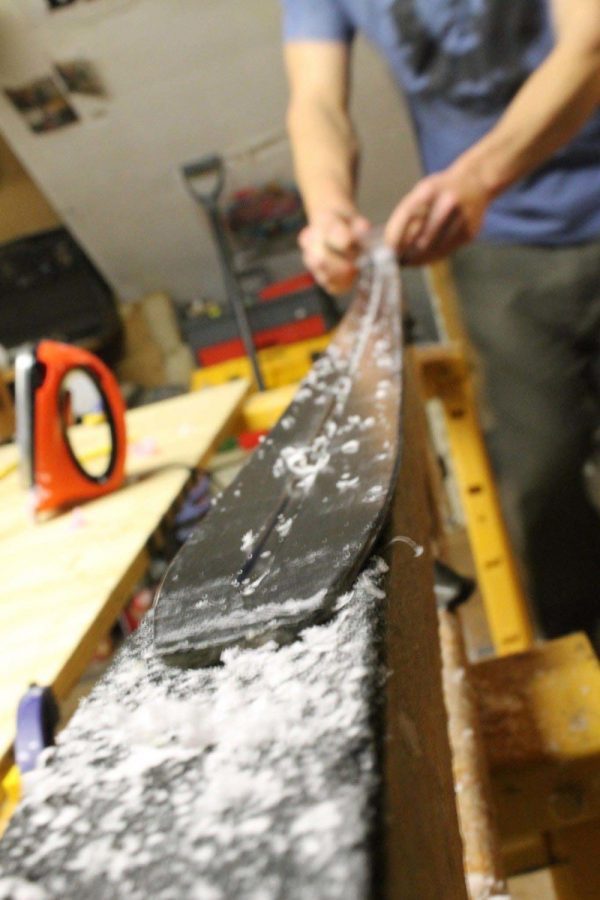Waxed On, Never Waxed Off
January 30, 2020
Nearly a decade ago, a team of Swedish researchers at Orebro University tracked eight world cup wax technicians’ blood levels of Perfluorooctanoic acid (or PFOA — a chemical found in some of the fastest ski waxes). An unexposed, or control, group was found to have on average 2.7 nanograms of PFOA per milligram of blood. The wax techs boasted a number over 40 times larger–112.
Just this month, another group of Swedish scientists identified eleven waxes still containing significant levels of PFOA. Researchers involved said the wax manufacturers had claimed that they had moved on from PFOAs, but the waxes tested contained up to 1,200 times the amount of PFOA allowed under a new threshold set to take effect this summer.
In a 2019 report, Food and Water Watch said that “these chemicals are forever,” referring to PFOAs and similar substances. The acid stays in the environment, and doesn’t leave.
“These substances continue to persist in the environment and in our bodies even after a partial phase-out of their production in the United States,” the report read. “They’re resistant to even the most advanced water treatment technologies.”
Fluorinated waxes–a broader category, the fastest of which include PFOA–have endured criticism from coaches, scientists, and officials for years, especially for their health and environmental footprints. Bloomberg’s Will Donahue wrote of the sport’s “Dirty Little Fluorinated Secret,” describing fluoros as an addiction. The EPA has been investigating the substances, and has categorized the waxes as in violation with US toxic chemical legislation. Leagues across the world have set bans.
Vermont has set a ban, said Greene. So has New York. So has the Massachusetts state team qualifier. The European Union is banning the import, sale, and production of PFOAs in 2020 and fluorocarbons, the acid’s close sibling, two years later.
Early this winter, the International Ski Federation (FIS) announced a ban on the waxes for competitions starting in the 2020-2021 season.
And 41 days after the pros voted to de-fluorinate, the Berkshire Nordic Ski League followed suit.
“It seemed to us like a no-brainer,” Greene said. “Why would we ever continue to use it?”
Greene said once league coaches started hearing about the bans in Europe and gained access to more information regarding environmental and health concerns of fluorinated waxes, they met to discuss. Greene and fellow Greylock coach Hiram Greene pushed for a Berkshire League ban.
“Coach [Hiram] Greene said that even if the league doesn’t ban them, Mt. Greylock’s not using them,” Greene said.
Also at the meeting was Bazzano, who said the ban was a frantic decision.
“I was the antagonist,” Bazzano said. “The decision was made quickly. I feel that it was made without all the facts. It was more like ‘it’s a good idea, let’s just do it.’ I just didn’t feel like that was a decision to make that quickly.”
Bazzano said he questioned some of the information used to decide.
“In Norway, only U16 is using fluoro,” he said. “Everybody above U16 is using fluoro. That’s kind of information we got afterwards. We’ve been using Low Fluoros for 30 years. We just didn’t see health issues right away; we didn’t see it as an issue. Health issues have been reported for wax techs on the world tour, but I think they’re in a different element than we are.”
“In my mind, that was ridiculous,” Greene said, referring to such dissent at the meeting. “We don’t know everything, we’re still learning about them. Just inhaling the particulates is really bad for people.”
Greene said concern over the ban also originated from financial reasons–that a coach had already bought fluorinated waxes for the season.
Senior captain Miriam Bakija said that avoiding the ban for financial reasons would be “really stupid.”
“In the long run, regardless of whether you’ve bought them already, everybody’s going to be saving money by not using these super expensive fluorinated waxes,” she said.
Green noted that eliminating fluorinated waxes can level the playing field financially.
“It should be a concern,” she said, “because it shouldn’t be that the skiers with the most money get to be the fastest on skis.”
“Some people and teams can’t afford to buy fluorinated waxes,” Bakija said. “And in a sport in which so much of your race depends on the equipment you have, it’s nice to level the playing field in some way.”
In the end, the league voted to ban the use of all fluorinated products from racing. According to the new rules, skiers must wax as a team with NF (non-fluoro) and their skis must be stored overnight in a consolidated location.
Fifty percent of respondents to the Echo’s survey said they strongly supported the league’s ban on fluorinated waxes. Only one respondent reported they strongly disapproved of the decision. Reasoning largely captured the sentiment of the coaches who voted on the ban.
“If there are ways to help the environment then we should support that,” one respondent said. “Communities all over should do their best to not contribute to the climate crisis,” another noted.
Skiers also appeared to be concerned about the health impact, saying that “it is good to lower risky health factors” and noting that “without proper ventilation kids can be exposed to toxic fumes.”
But other skiers noted the complexity of the situation.
“I definitely support the decision, but it does raise some issues in the sport,” one said. “It makes it far easier to cheat the system now by using the better wax that has been banned because there is no way to actually regulate what people are putting on their skis.”
